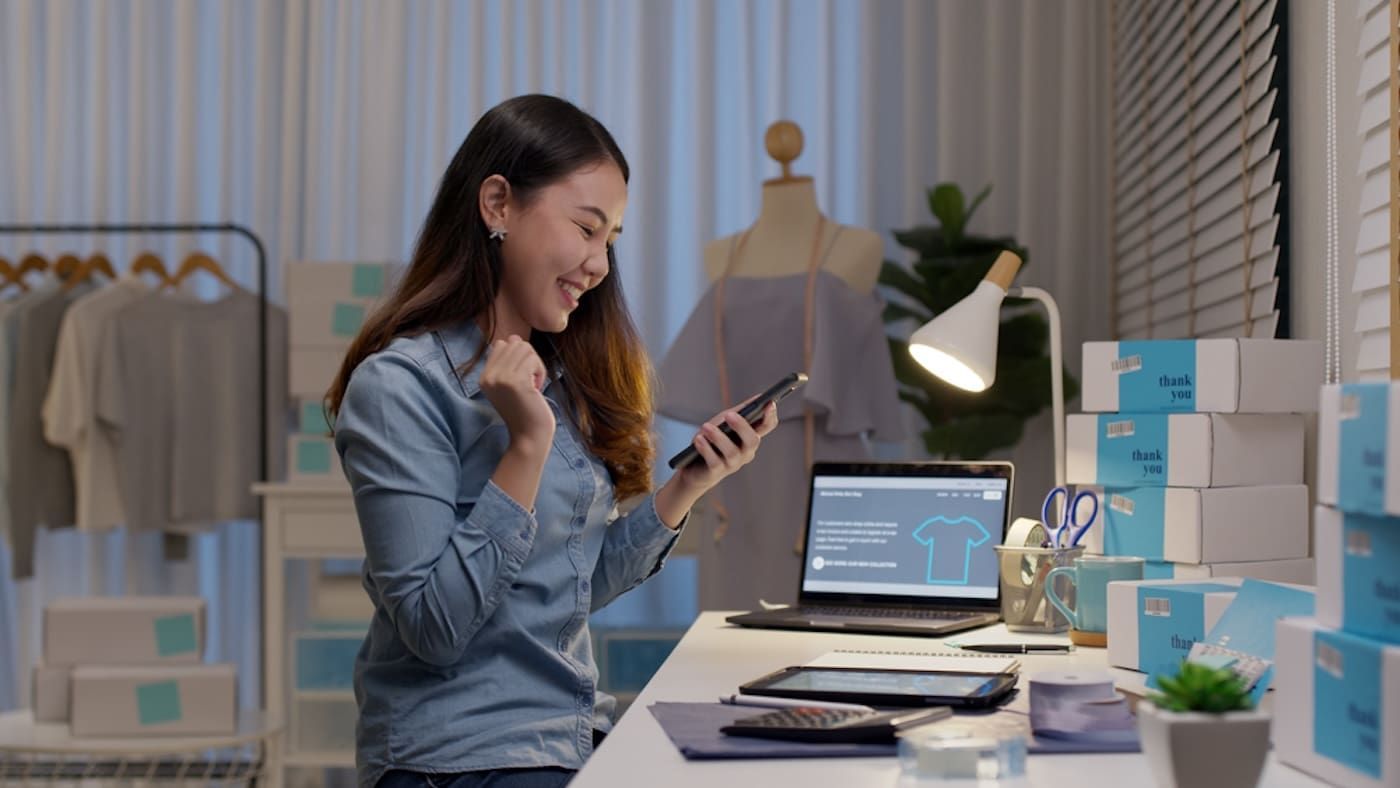How To Start A Flower Business In 10 Steps

By Stefani Anderson
Updated: Feb 06, 2024

With the floral industry enjoying rapid growth worldwide, there's never been a better time to learn how to start your own flower business.
You can set up a flower shop in your local area or establish an online floral design business and reach a broader target market nationwide.
In this guide, we've outlined the core steps you need to take to establish a unique and compelling floral business to earn extra money.
What Is A Flower Business?
A flower business, otherwise known as a florist, is a service business that specializes in arranging flowers for weddings, funeral homes, and other events.
Like other great service business ideas, it's easy to set up, with relatively low initial overheads and costs to launch the endeavor.
Flower business owners can work with various clients, from individuals looking for a Valentine's Day bouquet to wedding and corporate event planners.
This means forging relationships with flower suppliers capable of regular deliveries to ensure fresh flowers are delivered when needed.
While some flower businesses operate from retail flower shops, others are strictly based online and take orders through their e-commerce platform.
They comprise a notable proportion of local businesses in America and worldwide and are sometimes integrated into neighborhood grocery stores.
Flower shops also often hire dedicated floral designers to assist with creating beautiful flower arrangements for their customers' special occasions.
Reasons To Start a Flower Business In 2024
Setting up a new business can be challenging, whether starting a makeup line or developing a business plan for a retail flower shop.
But with an annual turnover of over $9 billion, there are plenty of opportunities to enter the floral industry and turn a profit with your business.
Here are a few other great reasons why setting up your flower shop and showcasing your creativity could be a good business decision:
- A floral design business can be run from home. Having a physical flower shop isn't essential for a floral service, and you can start a small business at home before expanding.
- It's a great way to monetize your creative side. Floral designers who want to make money while sharing their passion can kill two birds with one stone by setting up a flower business.
- The initial outlay doesn't have to cost a fortune. If you're starting with a handful of clients, you can purchase the tools and flowers without breaking the bank.
- The floral business is a growing market. The demand for cut flowers has been expanding year-on-year, making it a compelling growth industry with a profitable future.
- Setting up a floral business website is easier than ever. With plenty of easy-to-use tools for creating a stunning website, you can build your online business in just a few hours.
There are many other reasons to consider setting up a floral business and bringing a personalized touch to your customer base.
Now, let's explore how to start a flower business in more detail, from setting up a business bank account to creating marketing materials for promotion.
How To Start A Flower Business In 10 Steps
Whether you're passionate about floral design or want to generate revenue by selling flowers, setting up a floral shop is a popular small business idea.
In this guide, we'll explore the factors to consider when you start a floral business, from researching other flower shops to establishing a pricing structure.
So, now we've covered the basics, here's our ten-step guide outlining everything you need to know to start a flower business in 2024:
Step 1: Research Other Flower Businesses
Whatever the nature of a small business enterprise, you must perform extensive research into your competition before anything else.
While you may think you have a clear idea of how to proceed, this research will inevitably throw up aspects you may otherwise have overlooked.
This can be something as simple as inspiration for funny business names or how to structure your website design to showcase your products.
Different flower businesses also take different approaches to their overall business model and the target market they hope to reach.
Running a flower shop requires an effective pricing strategy, so checking out the competition will help you charge a suitable rate to potential customers.
You can also learn how to handle your flowers with the proper care needed to keep them fresh and increase their shelf life in your store.
Step 2: Determine Your Flower Business Model
With your competitor research completed, you can apply what you've learned from this process to your flower shop business model.
If you're working around a busy stay-at-home mom schedule or an existing day job, you can factor in the hours needed to get your flower business running.
On the other hand, if you're opening a physical store, your model will need to include information on expected foot traffic and other variables.
A completely online business has its own set of various factors to consider in your startup costs, such as whether you have access to a delivery vehicle.
The nature of your potential customers is also a key factor to bear in mind when determining what your flower business model is going to be.
For example, if you're hoping to serve corporate event planners, you'll need access to a wholesale source capable of meeting demand.
Alternatively, if you're a small-scale floral designer hoping to sell flowers to individuals, your business model won't need to be as detailed.
Step 3: Draw Up A Detailed Business Plan
Once you're clear on the model you want your flower shop to emulate, it's time to create a business plan.
While a business plan is essential if you're hoping to get investment in your company, it's still vital for outlining the key steps needed to proceed.
This is equally true for those investing in a side hustle to pay off debt as it is for those creating a big business with multiple outlets.
Start by outlining your overall goals and objectives, detailing all your expenses to acquire the necessary tools and source of flowers.
Next, use this information to draft a pricing structure and how these correspond to your various floral arrangements and other services.
Your business plan should also factor in the expected costs for marketing efforts and social media channels to reach your customers.
If you're hoping to offer discounts, ensure these are included in your breakdown of how much money you need to launch your flower shop.
Finally, weigh up your potential revenue stream with projected profit margins and any ongoing operating expenses to keep the company running.
Once your business plan has been finalized, refer to it regularly to see if you're meeting your goals and competing with other businesses.
If necessary, you can adjust your operating procedures and reevaluate your business priorities.
Step 4: Choose Your Name & Branding Style
For your floral business to stand out, it requires a striking business name with accompanying branding designs.
This is as true for a brick-and-mortar floral shop as it is for an online store and should capture the essence of your company at a glance.
Through your competitor research, you'll have a good grasp of the kind of names other businesses use to market their services to potential customers.
When setting up your online store, you can use a website builder and select a suitable template to use as a starting point for your site.
You can incorporate your floral designer skills to create a visually appealing set of images for your company logo and other branding elements.
This should showcase your capabilities for delivering beautiful floral arrangements that wedding planners and other customers will find appealing.
All branding elements should be tested across various platforms to ensure they appear as intended at a variety of resolutions and in print.
Step 5: Invest In The Necessary Equipment
Creating stunning floral arrangements requires the correct tools for the job, so you'll need to invest in these from the outset.
This includes purchasing flower buckets for your displays at a physical store and other tools such as clippers, trimmers, and knives.
Make a list of any additional implements necessary for arranging flowers and picking up spares so you're not caught in a tight spot if anything breaks.
If you plan on selling home accessories to your clients, include these in your inventory and overall budget for equipment.
In addition to tools, you'll also need accessories that require ongoing orders to fulfill your business requirements over the long term.
Floral tape, foam, wire, and cages are just a few items needed to bundle fresh stems and keep your arrangements together.
While new business owners have to employ guesswork regarding ongoing costs, these expenses will become more accurate to predict over time.
You can upgrade your tools to better models as your profits increase, and your experience designing floral arrangements progresses.
Step 6: Master Your Floral Design Skills
Creating beautiful floral arrangements that bring joy to customers eager to purchase is a continual process and learning experience.
As such, you should dedicate some time to honing your floral designer skills to increase the scope of your products.
There is no shortage of online tutorial videos and content from other florists to help you improve your talent stack, so bookmark these in your browser.
The more you practice, the faster your overall process will become, allowing you to meet demand for a larger market and increase profits.
These skills can also be integrated into your online marketing channels, sharing high-quality workflow images and connecting with customers.
You can access some of the best tools for freelancers to bring a professional touch to this material, editing short videos for Instagram and TikTok.
As your skills improve, you can use this to enhance your brand's identity and acquire clients who are prepared to pay extra for your work.
Step 7: Choose The Location For Your Flower Shop
While many businesses have left physical stores behind in favor of a strictly online presence, florists remain high-street fixtures.
Unlike some products, customers prefer to check out flowers and arrangements in person to assess their quality across a range of senses.
A website is a great place to share high-quality photographs, but it can't capture the scent and texture of the various plant and flower types.
If you plan on opening a traditional flower shop, your research will help you track down a prime location with plenty of foot traffic.
Prime locations for flower shops include rental properties close to railway and subway stations and other high-traffic commuter destinations.
On the other hand, small towns and villages that don't already have a florist can also present opportunities for access to an untapped market.
Getting a great deal can be time-consuming, and you should investigate commercial real estate in your area to get the best possible deal.
Your rental costs can then be assessed appropriately regarding your overall startup and running costs to determine if it's worth the investment.
Step 8: Build Your Website & Online Store
All florists require an online presence, which can be used for marketing initiatives, building customer relationships, and selling flowers.
If you're focusing on a florist shop, you'll still need a basic website to market locally and give your repeat customers more pre-order options.
On the other hand, if you plan on prioritizing your online store and digital marketing drives, a more comprehensive website will be required.
This means choosing one with an e-commerce website builder, which can be used to add inventory and manage orders.
These tools are easy to use and can be quickly integrated with various popular payment methods such as PayPal and credit card transactions.
E-commerce builders also allow customers to rate and review your products, which can be an effective tool for driving additional sales.
It can take some time to get all your inventory listed, but once it's sorted, the platform's automated functions simplify the process.
Step 9: Promote To Your Target Market
With your supplies ready to sell and your online store up and running, it's time to reach out to potential customers through marketing campaigns.
There are many options you can try when marketing your florist business, ranging from traditional print ad campaigns to boosting posts on social media.
Platforms such as Facebook and TikTok allow users to create marketing campaigns for all budgets that can be set to your local area.
When setting up such campaigns, make sure you use the best images of your floral arrangements, hiring a professional photographer if necessary.
You can also test different campaigns using the A/B testing method, comparing and analyzing the data to see which visual assets work best.
Digital marketing campaigns are also effective for generating word of mouth and interacting with comments on your promotional posts.
If you have the budget, you can work with influencers on affiliate programs who will promote your florist business to their social media followers.
As your profits increase, this can be reinvested in more extensive marketing campaigns based on specific events and seasonal holidays when demand is at its highest.
Step 10: Gather Feedback From Your Customers
Developing long-term customer relationships guarantees repeat business and a consistent revenue stream for your florists.
This is especially important if you're positioning your company as a large supplier for wedding planners and other businesses such as funeral homes.
We've touched on the importance of reviews and ratings for e-commerce sellers, and your website can offer plenty of other opportunities for feedback.
Including a blog section and sharing your journey as a floral designer will deliver strong engagement and help customers connect with your work.
It's also an opportunity to share guest posts and transform your website into its own distinct source of consistent passive income.
Social media is another great outlet for forging long-lasting relationships with like-minded flower lovers who might appreciate your design style.
There are hundreds of popular Facebook mom groups, as well as many more dedicated to plants and wildlife lovers, where they share their passion.
Responding to feedback shouldn't be time-consuming, and you can check for new comments on your smartphone whenever you have a few spare moments.
If you're working in a brick-and-mortar florist, it's much easier to establish a relationship with customers through casual conversations.
As with engaging online, this can be an invaluable approach to building word of mouth and making your florist business a viable success.
Summary
Starting any new venture can be challenging, but we hope this guide to establishing a floral business has helped you understand the work involved.
If you're new to floral design, you can hone your skills with an online course and other free training material to stand out from other florists.
By gathering feedback and working with new customers, it's possible to transform a side business into a full-time company that generates consistent income.
CREATE YOUR OWN WEBSITE
As a mom of three, writing became Stefani’s creative outlet, quickly evolving into a part-time side hustle she could do during nap time. After realizing, she had a knack for writing, Stefani pursued it as a profession and now heads up Friday's content. When she's not wordsmithing for Friday, Stefani enjoys playing at the park with her family, snowboarding, and trying new food.
This blog was created proudly with the Friday Website Builder










